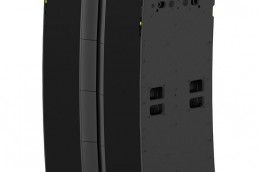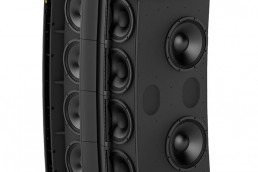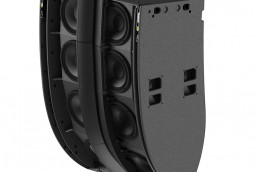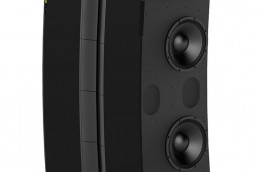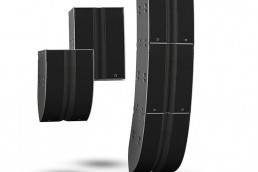This website uses cookies so that we can provide you with the best user experience possible. Cookie information is stored in your browser and performs functions such as recognising you when you return to our website and helping our team to understand which sections of the website you find most interesting and useful.
L-Acoustics L Series
ProjectL-Acoustics L SeriesLocationThe AmericasManufacturersL-AcousticsSubmitted byL-Acoustics
The L-Acoustics L Series is a pioneering achievement in the audio industry, merging cutting-edge acoustic technology with an unwavering commitment to sustainability. This new line array system enhances the audience’s sound experience and significantly reduces the environmental impact of live sound operations, making it a deserving candidate for a sustainability award.
Designed with the dual elements of L2 and L2D, the L Series incorporates advanced audio engineering to focus sound directly toward the audience, thereby minimising noise pollution. This targeted approach ensures that sound energy is concentrated where needed most, reducing the spillover into surrounding areas, often leading to environmental disturbances. Each L2 and L2D unit is equipped with eight three-inch high-frequency drivers, eight ten-inch low-frequency drivers, and four side-loaded 12-inch drivers, all working to deliver precise and powerful sound coverage. Users can choose between cardioid or super-cardioid patterns, optimising sound directionality and limiting unwanted acoustic leakage.
One of the L Series’ key innovations is its structural design. The series features a seamless rigging system without inter-element angles, a pinless auto-lock mechanism, and a single cable connector. This streamlined design simplifies the setup and teardown processes and substantially decreases the likelihood of errors during assembly. The result is a threefold reduction in loading time compared to the previous K2 configuration. Such efficiency saves time and significantly reduces the energy and resources typically expended during these operations.
Moreover, the L Series has been developed with an acute awareness of material usage and environmental impact. By achieving a 56% reduction in paint use, 30% less wood, and 60% less steel compared to conventional systems, L-Acoustics demonstrates a robust commitment to reducing the ecological footprint of its products. These material savings contribute not only to the conservation of resources but also to a reduction in the overall weight and volume of the system.
Weighing 25% less and occupying 30% less volume than equivalent line source arrays, the L Series is notably more compact and lighter. This reduction in size and weight translates directly into lower transportation costs and decreased fuel consumption, further diminishing the carbon footprint of touring and event operations. By requiring less truck space, the L Series cuts down on logistic costs and significantly reduces greenhouse gas emissions associated with equipment transport.
The new L Series represents a significant step forward in sustainable sound system design, illustrating how cutting-edge technology can merge superior performance with environmental consciousness. This product line, including the L2 and L2D elements, is not only engineered for optimal sound delivery across various settings but also designed with significant considerations for sustainability in terms of materials, energy efficiency, and logistical improvements.
Central to the L Series’ design is the Progressive Ultra-dense Line Source (PULS) technology used in the L2, which ensures high-quality audio performance while maintaining compact and lightweight characteristics. This innovation is crucial for sustainability as it allows the L2 to achieve a high sound pressure level (SPL) per unit of line length, reducing the number of modules required for adequate coverage. Consequently, fewer resources are used in the manufacturing process, reducing the carbon footprint associated with production and material usage.
The L2’s construction incorporates high-density component placement, including eight 3″ compression drivers on DOSC waveguides, eight 10″ drivers, and four 12″ drivers, maximising space and enhancing the element’s energy efficiency. By consolidating multiple components into a single module, the L2 reduces power consumption during operation. Additionally, the integrated 16 channels of DSP and amplification from the LA7.16 provide precise control over the audio output, ensuring efficient sound distribution and minimising energy waste.
One of the standout features of the L Series in terms of sustainability is its size and weight advantages. The L2 and L2D units are designed to be 46% smaller and 40% lighter than traditional line arrays. This reduction in size and weight decreases the raw materials used in manufacturing and significantly cuts down on transportation emissions. Fewer trucks are required to transport the same amount of audio capacity, leading to lower fuel consumption and reduced greenhouse gas emissions during tours or events.
Furthermore, the ease of setup inherent in the L Series design contributes to its sustainable profile. The units feature a captive rigging system allowing quick, secure assembly without needing angle adjustments, reducing setup times and labor costs. This efficient rigging system speeds up deployment and lessens the environmental impact by reducing the energy and resources typically consumed during lengthy installation processes.
Additionally, the modular nature of the L2 and L2D allows for scalable audio solutions, meaning that systems can be tailored specifically to event sizes, avoiding the energy and material excess of larger, fixed installations. This adaptability ensures that the sound system’s environmental impact is aligned with actual usage needs, avoiding overproduction and waste.
In summary, the L Series from L-Acoustics exemplifies how technological advancement can be leveraged to achieve sustainability in the professional audio industry. By focusing on energy efficiency, reduced material usage, and improved logistical operations, L-Acoustics enhances the audio experience and significantly contributes to the global effort to reduce the entertainment industry’s environmental impact.
The L Series enhances live sound delivery while simultaneously reducing environmental impacts, embodying a comprehensive approach to eco-friendly design. It focuses on several critical areas of sustainability: material use, operational efficiency, and noise pollution.
The construction of the L Series uses significantly fewer resources than traditional systems. It achieves a 56% reduction in paint, 30% less wood, and 60% less steel. These reductions minimise waste and decrease the environmental burden associated with the production and disposal of audio equipment. The series is 30% less voluminous and 25% lighter than standard systems, simplifying logistics and reducing the need for truck space. Consequently, this leads to lower fuel consumption and fewer carbon emissions during transportation.
The series also streamlines the setup and teardown process with its innovative rigging system, which features no inter-element angles and a pin-less auto-lock mechanism, coupled with a single cable connector. This design drastically cuts the time and energy typically required for these operations, saving labour costs and reducing the energy used during prolonged operational times.
Furthermore, the L Series minimises sound spill over and reduces noise pollution by focusing sound more precisely towards the audience. This targeted sound delivery is crucial for outdoor events, where noise leakage can disturb local communities and wildlife. By concentrating sound energy efficiently and effectively, the L Series ensures optimal audio experiences for audiences while respecting the broader environmental context.
Through these innovations, the L-Acoustics L Series demonstrates how audio technology can progress toward more sustainable practices without compromising performance, serving as a model for future developments in the industry.
The creation of the L Series by L-Acoustics was driven by providing the best possible sound experience for audiences while addressing several environmental and practical challenges that large-scale sound reinforcement systems face. This initiative was rooted in the necessity of delivering consistent and homogeneous Sound Pressure Level (SPL) distribution and frequency response across audience areas, ensuring optimal auditory experiences without compromising the health of the audience and workers and minimizing environmental noise pollution, especially crucial for outdoor events.
One of the primary challenges in developing the L Series was managing the SPL at large distances, a significant concern in outdoor settings where sound propagation can be influenced by atmospheric conditions like wind, temperature gradients, and ground impedance. The L-Acoustics Education team tackled these issues using advanced simulation techniques using Three-Dimensional Parabolic Equations (3DPE). This method allowed them to model how different atmospheric conditions affect sound levels at considerable distances, using real loudspeaker system models to enhance the accuracy of these simulations.
The research underpinning the L Series development was thorough, focusing on comparing the impact of flown versus ground-stacked subwoofers on sound propagation and noise pollution. Ground-stacked subwoofers showed higher variability in far-field SPL under varying atmospheric conditions compared to flown subwoofers, particularly at higher crossover frequencies. This finding was critical as it influenced the decision to prefer flown configurations in the L Series to ensure more stable sound performance across varying environmental conditions.
The study also delved into the influence of crossover frequencies between main systems and subwoofers on sound quality and noise pollution. It was found that higher crossover frequencies could exacerbate variability in SPL due to atmospheric conditions when using ground-stacked subwoofers. Conversely, flown subwoofers provided a more controlled and consistent sound output, making them a better option for reducing environmental noise pollution and ensuring a stable listening experience.
An additional challenge addressed by the L Series development was the need to consider low-frequency noise pollution, which often goes unregulated yet can be significant at the sides of a sound system. Here, the choice of subwoofer configuration and the strategic use of subwoofer arcs became important design considerations aimed at reducing noise spill into surrounding areas while maintaining sound quality within the intended audience zone.
The development of the L Series was not just about technological innovation but also about integrating environmental considerations into the design process. By choosing configurations that mitigate noise pollution and improve the consistency of sound delivery under various ecological conditions, L-Acoustics not only enhanced the audience’s auditory experience but also took significant steps toward responsible sound system design. This approach reflects a comprehensive understanding of the complexities involved in large-scale audio system deployment, emphasising sustainability and health alongside acoustic excellence.
Testimonials/Quotes:
Randy Hawkins, A1 at The Palace Theatre and former house engineer at First Avenue: “I had the EQ flatter than ever, and I even had the subs and bus compressor turned down -7dB and we still hit 124dB C-weighted! That’s how transparent and powerful the L Series is. It’s surprisingly powerful for its size. But with the L Series, it was clear from the front to the back of the house, and it didn’t change a bit from soundcheck to downbeat. The buildup of the low-mids that often happens in that room didn’t happen.”
Alex Johnson, Lead Audio for First Avenue: “The new L2/L2D system has dramatically improved many of the challenges engineers and audiences faced in First Avenue. For audience members, coverage, clarity, and sightlines are better than ever. For engineers, there is better frequency response, stereo imaging, sub-extension, and headroom. The best improvement is how much less things change from soundcheck to show.”
Tyler Thomas, Technical Lead at Allied for the installation: “With the L-Acoustics L Series, we are achieving maximum sonic consistency and even coverage across the entire venue, so no matter where you are in the room, you will have an excellent experience. The L2D greatly assists with mechanically attenuating the SPL to make sure we have the appropriate amount of headroom while also not producing harmful volume levels in front of the audience, and its internal cardioid driver stops the low end from building up on stage. It also provides an extra-wide 140-degree horizontal pattern to adequately cover the entire front row without the need for placing front-fills on an already crowded stage. The L Series’ low profile has also given better sightlines to the stage from every audience vantage point in the house.”
